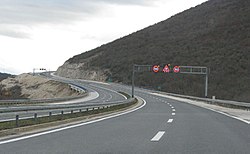
Back Автомагистрала А1 (Хърватия) Bulgarian Autoput A1 (Hrvatska) BS Dálnice A1 (Chorvatsko) Czech Autocesta A1 German Kroata aŭtovojo A1 Esperanto A1 (Croacia) Spanish Autoroute A1 (Croatie) French Autocesta A1 Croatian A1-es autópálya (Horvátország) Hungarian Autocesta A1 Italian
| A1 motorway | |
|---|---|
| Autocesta A1 | |
| Dalmatina | |
 | |
| Route information | |
| Part of | |
| Length | 476.3 km (296.0 mi) 550.0 km (341.8 mi) planned[1] |
| Major junctions | |
| North end | |
| South end | |
| Location | |
| Country | Croatia |
| Counties | City of Zagreb, Zagreb, Karlovac, Lika-Senj, Zadar, Šibenik-Knin, Split-Dalmatia, Dubrovnik-Neretva |
| Major cities | Zagreb, Karlovac, Zadar, Šibenik, Split, Ploče, Dubrovnik |
| Highway system | |
The A1 motorway (Croatian: Autocesta A1) is the longest motorway in Croatia, spanning 476.3 kilometers (296.0 mi). As it connects the nation's capital Zagreb, in the north of the country, to the second largest city Split on the shore of the Adriatic Sea, the motorway represents a major north–south transportation corridor in Croatia and a significant part of the Adriatic–Ionian motorway. Apart from Zagreb and Split, the A1 motorway runs near a number of major Croatian cities, provides access to several national parks or nature parks, world heritage sites, and numerous resorts, especially along the Adriatic Coast. National significance of the motorway is reflected through its positive economic impact on the cities and towns it connects as well as its importance to tourism in Croatia.

The motorway consists of two traffic lanes and an emergency lane in each driving direction separated by a central reservation. All intersections of the A1 motorway are grade separated. As the route traverses rugged mountainous and coastal terrain, it has required 376 bridges, viaducts, tunnels and other similar structures in sections completed as of 2014[update], including the two longest tunnels in Croatia and two bridges comprising spans of 200 meters (660 ft) or more. There are 33 exits and 26 rest areas operating along the route. As the motorway is tolled using a ticket system and vehicle classification in Croatia, each exit includes a toll plaza.
A motorway connecting Zagreb and Split was designed in the early 1970s, and a public loan was started in order to collect sufficient funds for its construction. However, due to political upheavals in Croatia and Yugoslavia, construction of the motorway was labeled a "nationalist project" and cancelled in 1971. After Croatian independence and the conclusion of the Croatian War of Independence, efforts to build the motorway were renewed and construction started in 2000. The Zagreb–Split section of the route was completed by 2005, while the first sections between Split and Dubrovnik opened in 2007 and 2008. Construction costs incurred so far amount to 3 billion euro. The figure includes funds approved for construction work scheduled to be completed by 2013.[needs update] On the other hand, the amount does not include construction cost related to Lučko–Bosiljevo 2 section since that section was funded as a part of Rijeka–Zagreb motorway construction project through Autocesta Rijeka–Zagreb, current operator of that sector. The remainder of the A1 motorway, i.e., the sections south of the Bosiljevo 2 interchange are operated by Hrvatske autoceste.
